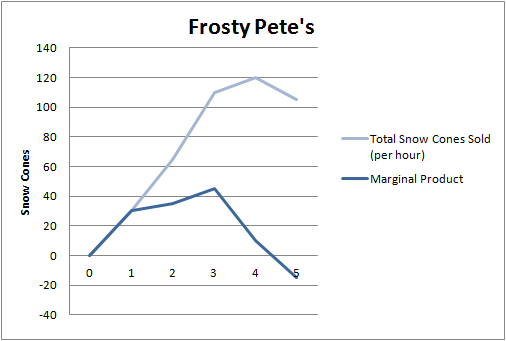The Link Between Economics & Your Website
It’s no mystery that a website is a necessity for any business to thrive in today’s economy. But what is it that makes the difference between an effective website and one that overwhelms or fails to connect with visitors? One answer to this question can be found within the world of economics.
I’m currently three weeks into my second of two economics classes as I work toward my master’s degree. My feelings toward this subject thus far are….not favorable. Attempting to interpret how lines and curves represent the viability of a business or country at large has made my head spin on several occasions. I’m crossing my fingers to understand enough of the concepts to get a passing grade and keep my time with economics to a minimum.
There is one economic principle that I’ve learned over the past few weeks, however, that I find fascinating: the law of diminishing returns. This principle states that, as long as resources remain fixed, companies will eventually reach a point where the marginal product of hiring a new employee will be less than the marginal product received from the previous employee. Confused? Let me explain with a quick example.
Shaved Ice, Syrup & Marginal Product
Imagine a small snow cone shack called Frosty Pete’s. With a single employee, Frosty Pete’s can sell 30 snow cones per hour. By hiring an additional employee, their total snow cone sales increase to 65 snow cones per hour. The additional 35 snow cones that Frosty Pete’s is able to sell are what economists call the marginal product. Hiring a third employee continues this trend to a whopping 110 snow cones per hour, which represents a marginal product of 45 snow cones for the increase from two employees to three.
You might assume that Frosty Pete’s can continue to hire workers and their marginal product and total revenue will continue to increase. This isn’t necessarily the case. In our example, a fourth employee only equals 120 total snow cones per hour and a marginal product of 10. A fifth employee drops the amount of snow cones produced to 105 and the marginal product to minus 15.
This graph demonstrates the trends mentioned above:
 So what is it that causes this upward trend to suddenly take a nosedive? At first, new employees allow Frosty Pete’s to be more efficient via specialization. The first employee can run the cash register while the second makes and distributes the snow cones, for example. A third employee could keep things rolling by taking orders, cleaning up, grabbing supplies, etc. But our fictional establishment doesn’t see the same uptick in marginal product when hiring a fourth employee. It’s not because this person is lazy or incompetent; they either won’t have enough to do or will just get in the way. Things get even worse with the fifth employee as both marginal product and total sales begin to fall.
So what is it that causes this upward trend to suddenly take a nosedive? At first, new employees allow Frosty Pete’s to be more efficient via specialization. The first employee can run the cash register while the second makes and distributes the snow cones, for example. A third employee could keep things rolling by taking orders, cleaning up, grabbing supplies, etc. But our fictional establishment doesn’t see the same uptick in marginal product when hiring a fourth employee. It’s not because this person is lazy or incompetent; they either won’t have enough to do or will just get in the way. Things get even worse with the fifth employee as both marginal product and total sales begin to fall.
The law of diminishing returns is applicable to all companies, although the number of employees that causes the trends to change will be different. The key for these companies is to find the right number of employees, their sweet spot if you will, so they can be as productive as possible without wasting resources. (Economic pro tip: This is where the marginal product equals marginal cost, or the price of hiring that additional employee).
Separating the Good Ideas From the Bad
Unless you sell snow cones for a living, you’re probably wondering what on earth this has to do with marketing your business. I feel like the principle of diminishing returns can apply to more than just hiring labor. A website, for example, is a very powerful tool that can enable any business owner to communicate with consumers, market new products, and much more. Putting the right amount of work into your site can help you create a new pipeline of customers and contacts for your business. Putting too much work into your site or focusing in the wrong areas could actually repel those who you are trying to attract.
Let me provide you with a few examples inspired by one of my favorite cartoon sketches aired during my childhood.
Website Design
Good Idea: Choosing a simple and consistent website design that will appeal to the modern consumer and allow them to easily find what they were looking for.
Bad Idea: Trying to make a statement with your website by choosing something way too over the top. You will likely just end up confusing the client or perhaps being listed on this website.
Forms & Widgets
Good Idea: Selecting a small number of forms or widgets that fit the theme of your site and provide a benefit to your visitors.
Bad Idea: Bombarding any web traffic you receive with multiple forms or unnecessary widgets and features. Not cool, man.
Keyword Phrase Selection
Good Idea: Focusing on keywords that are more likely to bring you a return on your investment. Long-tail terms are easier to rank for and are often searched for when a buyer is ready to make a decision.
Bad Idea: Narrowing your focus too much that your content becomes exclusionary. (Check out this blogThis term originated as shortened version of “web log” and has come to be known as a regularly updated web-page, often containing news, opinion and personal stories. for more information on keyword research).
Keyword Phrase Usage
Good Idea: Building pages around the specific products and services that you offer with your selected keyword phraseThese are the words or phrases users type into search engines as queries. in mind.
Bad Idea: Stuffing keywords into every available space of your website. This may have worked in the past, but Google has become smarter and we must follow suit.
Content
Good Idea: Including a few paragraphs of well-written content on each page that inform the customer and compel them to action (e.g., a phone call).
Bad Idea: Leaving the page blank, swiping content from Wikipedia, or rambling on forever. Any of these could be a major deterrent to potential clients.
Find Your Sweet Spot
Unlike economics, there is not an equation that we can use to find the exact sweet spot for your website marketing decisions. But through our years of experience in this business, we have something pretty close to it. We’ll combine your unique position in the market with tested services and software that have proven effective over the years. It will require a collaborative strategy in the beginning and a few adjustments along the way. But we’ll make sure you are doing what it takes, and not too much, to get a return on investment for your website. Give us a call today to see how we can help you.




